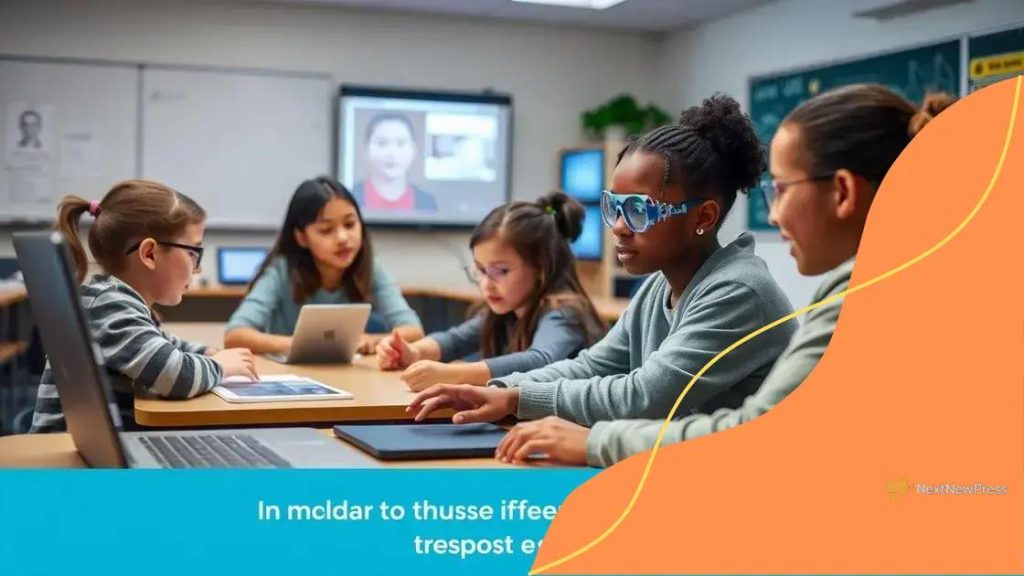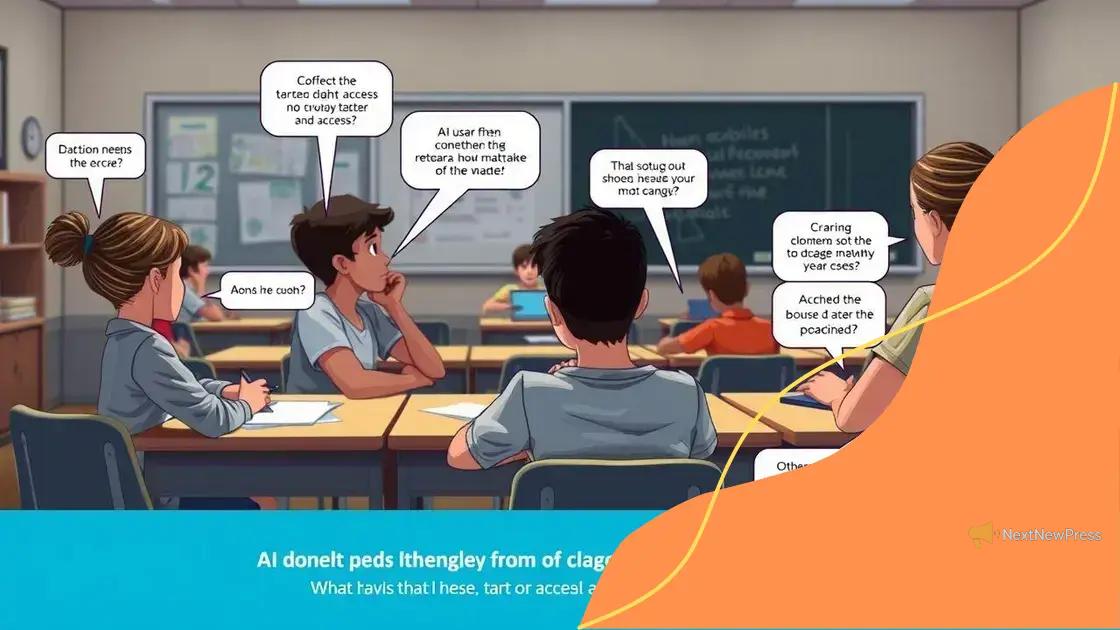AI tools in UK classrooms: transforming education

AI tools in UK classrooms enhance personalized learning, engage students, and support teachers by automating tasks, although they also present challenges like data privacy and access inequality.
AI tools in UK classrooms are changing the way students learn and teachers instruct. But how do these technologies truly affect our education system? Let’s dive into this transformation!
Benefits of integrating AI tools in classrooms
Integrating AI tools in classrooms brings numerous advantages. These tools can enhance student engagement and help personalize learning experiences. Imagine a classroom where lessons adapt in real-time based on a student’s understanding. With the help of AI, this is no longer just a dream.
Improved Student Engagement
AI tools can make learning more interactive. They can provide instant feedback, allowing students to learn at their own pace. For instance, platforms that use AI can analyze student performance and adjust content accordingly. This tailoring keeps students interested and motivated.
Personalized Learning Paths
Every student learns differently. By integrating AI tools, teachers can create customized learning experiences. These systems track progress and identify strengths and weaknesses. Here are some main benefits:
- Adaptive learning systems that adjust difficulty levels.
- Targeted resources to meet individual needs.
- Real-time assessments that inform teaching strategies.
- Increased access to diverse educational materials.
Furthermore, AI helps to reduce the workload for teachers. Administrative tasks can be automated, giving educators more time to focus on student interaction. This also allows teachers to spend more time developing creative lesson plans, enhancing the overall quality of education.
Another significant aspect is the ability to engage students in a relevant way. Many AI tools incorporate gamification, making learning enjoyable. This approach keeps students attentive, as they explore new concepts through interactive activities.
Enhanced Collaboration
AI tools encourage teamwork among students. Collaborative projects powered by AI can help students develop crucial skills. They learn to communicate, solve problems, and think critically together. Ultimately, these skills are vital in today’s society.
In summary, adopting AI tools in classrooms can create a more engaging, personalized, and efficient learning environment. The benefits are evident and transformative, shaping the future of education.
Popular AI tools used in UK education
Many AI tools used in UK education are making a significant impact on how students learn. These tools are not just trendy; they are effective in enhancing the educational experience. Here are some popular ones that you might find in classrooms today.
1. Google Classroom
This platform streamlines the process of managing assignments. It allows teachers to create, distribute, and grade assignments all in one place. Students get instant feedback, making it easier for them to understand their progress.
2. Kahoot!
Kahoot! is a game-based learning platform that makes lessons fun. Teachers create quizzes that students can answer in real-time using their devices. Its engaging format helps maintain student interest and reinforces learning.
3. Grammarly
Grammarly is an AI writing assistant that helps students improve their writing skills. It provides suggestions for grammar, punctuation, and style. This tool is especially useful for enhancing language proficiency in a supportive manner.
4. Classcraft
This tool uses gamification to boost student motivation. Classcraft turns the classroom into a game where students can earn points and rewards for positive behavior and academic achievements. This approach creates a more engaging learning environment.
5. Socrative
Socrative allows teachers to create quizzes for immediate assessment. It helps monitor student understanding in real-time. With features such as quick polls, teachers can adapt their lessons based on the feedback received.
These AI tools not only support teaching but also promote collaboration among students. They help in creating a blended learning environment where technology and traditional teaching methods go hand in hand. The adoption of these tools prepares students for a tech-savvy world, making learning both efficient and enjoyable.
Challenges of using AI in the classroom

Despite the benefits, using AI in the classroom comes with its own set of challenges. These hurdles can impact both teachers and students, making it crucial to address them effectively. Understanding these challenges can help schools better prepare for implementing AI tools.
1. Resistance to Change
Many educators may resist adopting AI tools due to fear or uncertainty. This skepticism can stem from a lack of training or understanding of how AI can enhance teaching. It’s vital to provide proper training and support to ease this transition.
2. Inequality in Access
Another significant challenge is the inequality in access to technology. Not all students have the same exposure to devices or the internet. This digital divide can hinder the effectiveness of AI tools in certain classrooms.
3. Data Privacy Concerns
With AI tools collecting data on students, there are valid concerns about privacy. Parents and educators worry about how this information is used and stored. Establishing clear guidelines around data protection is essential for alleviating these fears.
4. Dependence on Technology
Students may become overly reliant on AI, diminishing their critical thinking and problem-solving skills. While technology can assist learning, it should not replace essential human skills. Finding a balance is important.
Moreover, implementing AI in classrooms requires ongoing maintenance and updates. Schools need to budget for these expenses to ensure that their systems remain functional and effective. Without proper funding, even the best tools may fall short.
Finally, there’s the challenge of curriculum integration. Teachers need to seamlessly integrate AI tools into their existing lesson plans. This can be time-consuming and requires planning, making it another hurdle for educators.
The role of teachers with AI assistance
The integration of AI assistance in education reshapes the role of teachers in profound ways. Rather than replacing educators, AI serves as a powerful tool that enhances their teaching methods. This allows teachers to focus more on student engagement and personalized learning.
Supporting Personalized Learning
AI tools analyze individual student performances, helping teachers customize learning experiences. For instance, they can identify students who struggle with certain topics, allowing teachers to give extra attention where it’s needed the most. This tailored approach helps in improving overall academic performance.
Streamlining Administrative Tasks
One of the most beneficial aspects of AI assistance is its ability to handle repetitive administrative tasks. Teachers can automate grading, attendance, and scheduling tasks. This automation saves time, allowing educators to devote more time to planning lessons and interacting with students.
Enhancing Student Engagement
AI tools can create interactive lessons that capture students’ interest. By incorporating gamified elements and personalized feedback, these tools create a dynamic learning environment. Teachers can use these engaging resources to motivate students and inspire creativity.
Additionally, AI can provide resources that are aligned with the curriculum, giving teachers new options for delivering content. This ensures that lessons remain relevant and effective for diverse learning styles. When students are actively engaged, they are more likely to grasp and retain new information.
The collaboration between teachers and AI promotes a supportive learning atmosphere. Educators can work alongside AI to enhance their teaching strategies, allowing them to become facilitators of learning rather than just information providers. They guide students in leveraging technology, preparing them for a future where AI plays a significant role in various fields.
Future trends of AI in education
The future of AI in education looks promising as technology continues to evolve. Several emerging trends are shaping how students learn and teachers teach, making education more accessible and effective.
1. Increased Personalization
As AI becomes more advanced, personalization will reach new heights. Future AI tools will be able to create even more customized learning experiences. By analyzing performance data, these systems will adjust learning paths based on individual strengths and weaknesses. This means every student can receive the support they need to succeed.
2. Enhanced Learning Analytics
Learning analytics will become a crucial component of education. Educators will use AI-driven data insights to monitor student progress in real time. This data can inform teaching strategies and improve student outcomes. AI can identify patterns that teachers may overlook, ensuring that no student falls behind.
3. Virtual and Augmented Reality Integration
The integration of AI with virtual and augmented reality (VR/AR) will transform classroom experiences. Students could engage in immersive learning environments that enhance understanding of complex concepts. For instance, they may explore historical events or conduct science experiments in a virtual setting.
4. AI-Powered Tutoring Systems
AI tutoring systems are likely to become more prevalent. These systems can provide on-demand assistance to students, offering help anytime they need it. This 24/7 availability allows students to learn at their own pace, fostering independence.
Moreover, AI will help teachers develop interactive and engaging curricula that cater to diverse learning styles. By utilizing tools that adapt to various preferences, educators can create an inclusive environment for all students. Future classrooms will be more collaborative, allowing AI tools to facilitate group projects and peer learning.
With the rise of global online education platforms, AI will play a pivotal role in bridging gaps in education access. Students from different backgrounds will have opportunities to learn from the best resources worldwide, promoting equity in education.
FAQ – Frequently Asked Questions about AI in Education
What are the benefits of using AI in classrooms?
AI offers personalized learning experiences, increases student engagement, and helps teachers streamline administrative tasks.
How can AI tools help teachers manage their workload?
AI can automate repetitive tasks like grading and scheduling, giving teachers more time to focus on lesson planning and student interaction.
What challenges do schools face when implementing AI?
Challenges include resistance to change, data privacy concerns, and ensuring all students have access to the necessary technology.
What future trends can we expect for AI in education?
Future trends include greater personalization, enhanced learning analytics, and the integration of virtual and augmented reality in learning environments.





